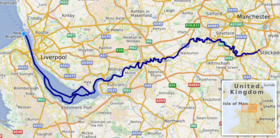| River Mersey | |
|---|---|
 The River Mersey at Liverpool, looking towards the Royal Liver Building | |
 The River Mersey is highlighted in blue interactive map Coordinates: 53°27′00″N 3°01′59″W / 53.45°N 3.033°W | |
| Location | |
| Country | England |
| Counties | Greater Manchester, Cheshire, Merseyside, Lancashire (Historic) |
| Cities | Liverpool, Manchester |
| Physical characteristics | |
| Source | (source of the River Tame) |
| • location | west of Buckstones Moss, West Yorkshire |
| • coordinates | 53°37′07″N 2°00′13″W / 53.6187°N 2.0035°W |
| • elevation | 1,552 ft (473 m) |
| 2nd source | (confluence of Tame and Goyt) |
| • location | Stockport, Greater Manchester |
| • coordinates | 53°24′51″N 2°09′23″W / 53.4143°N 2.1565°W |
| • elevation | 130 ft (40 m) |
| Mouth | |
• location | Liverpool Bay |
| Length | 69 mi (111 km) |
| Basin size | 1,810 sq mi (4,680 km2) |
| Basin features | |
| Designation | |
| Official name | Mersey Estuary |
| Designated | 20 December 1995 |
| Reference no. | 785[1] |
 | |
The River Mersey (/ˈmɜːrzi/) is a major river in North West England. Its name derives from Old English and means "boundary river", possibly referring to its having been a border between the ancient kingdoms of Mercia and Northumbria.[2] For centuries it has formed part of the boundary between the historic counties of Lancashire and Cheshire.[3]
The Mersey starts at the confluence of the River Tame and River Goyt in Stockport. It flows westwards through south Manchester, then into the Manchester Ship Canal near Irlam Locks, becoming a part of the canal and maintaining its water levels. After 4 miles (6.4 km) it exits the canal, flowing towards Warrington where it widens. It then narrows as it passes between Runcorn and Widnes. The river widens into a large estuary, which is 3 miles (4.8 km) across at its widest point near Ellesmere Port. The course of the river then turns northwards as the estuary narrows between Liverpool and Birkenhead on the Wirral Peninsula to the west, and empties into Liverpool Bay. In total the river flows 69 miles (111 km).[4]
Part of the Mersey Railway, a rail tunnel between Birkenhead and Liverpool opened in 1886. Two road tunnels pass under the estuary from Liverpool: the Queensway Tunnel opened in 1934 connecting the city to Birkenhead, and the Kingsway Tunnel, opened in 1971, to Wallasey. A road bridge, completed in 1961 and later named the Silver Jubilee Bridge, crosses between Runcorn and Widnes, adjacent to the Runcorn Railway Bridge which opened in 1868. A second road bridge, the Mersey Gateway, opened in October 2017, carrying a six-lane road connecting Runcorn's Central Expressway with Speke Road and Queensway in Widnes.[5] The Mersey Ferry operates between Pier Head in Liverpool and Woodside in Birkenhead and Seacombe, and has become a tourist attraction offering cruises that provide an overview of the river and surrounding areas.
Water quality in the Mersey was severely affected by industrialisation, and in 1985, the Mersey Basin Campaign was established to improve water quality and encourage waterside regeneration. In 2009 it was announced that the river is "cleaner than at any time since the industrial revolution" and is "now considered one of the cleanest in the UK". The Mersey Valley Countryside Warden Service manages local nature reserves such as Chorlton Ees and Sale Water Park.
The river gave its name to Merseybeat, developed by bands from Liverpool, notably the Beatles. In 1965 it was the subject of the top-ten hit single "Ferry Cross the Mersey" by Gerry and the Pacemakers.
- ^ "Mersey Estuary". Ramsar Sites Information Service. Retrieved 4 January 2022.
- ^ Arrowsmith, Peter (1997). Stockport: a History. Stockport: Stockport Metropolitan Borough Council. p. 21. ISBN 978-0-905164-99-1.
- ^ Mills, A D (1998). A dictionary of English place-names. Oxford: Oxford University Press. p. 240. ISBN 978-0-19-280074-9.
- ^ Clayton, Phil (2012). Headwaters: Walking to British River Sources (First ed.). London: Frances Lincoln Limited. p. 126. ISBN 9780711233638.
- ^ "Mersey Gateway Bridge is now open | The Mersey Gateway Project". merseygateway.co.uk. Archived from the original on 27 October 2017. Retrieved 27 October 2017.